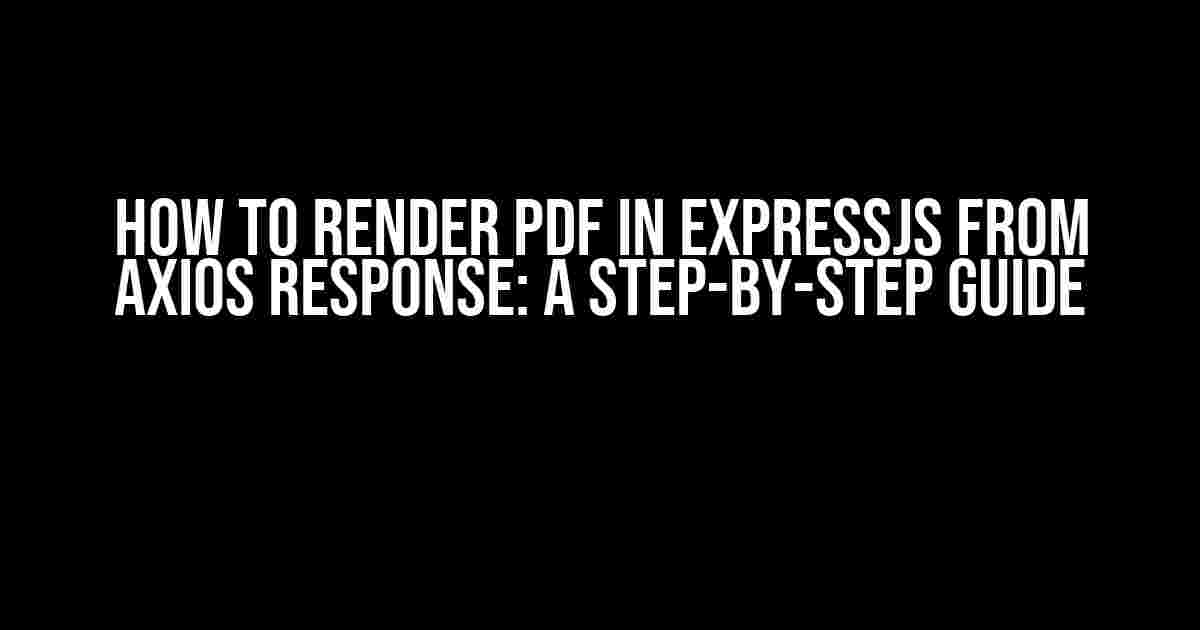Are you tired of struggling to render PDFs in your ExpressJS application from Axios responses? Well, worry no more! In this comprehensive guide, we’ll take you through a step-by-step process to achieve this feat. Buckle up, and let’s dive in!
What You’ll Need
- ExpressJS installed on your machine (if you haven’t already)
- Axios installed in your project (
npm install axios) - A PDF generator API or a URL that returns a PDF response
- A basic understanding of ExpressJS and Axios
Understanding the Problem
When working with APIs that return PDF responses, you might encounter difficulties rendering them directly in the browser. This is because the PDF response is not a typical HTML response, and the browser doesn’t know how to handle it.
That’s where ExpressJS and Axios come into play. By using Axios to make the API request and ExpressJS to handle the response, we can render the PDF in the browser seamlessly.
Step 1: Create an ExpressJS Route
First, let’s create an ExpressJS route that will handle the API request and response. In your ExpressJS project, create a new file (e.g., pdfRoute.js) and add the following code:
const express = require('express');
const router = express.Router();
const axios = require('axios');
router.get('/pdf', async (req, res) => {
// API URL that returns a PDF response
const apiUrl = 'https://api.example.com/get-pdf';
try {
const response = await axios.get(apiUrl, {
responseType: 'arraybuffer'
});
// We'll get to this part later
// ...
} catch (error) {
console.error(error);
res.status(500).send('Error rendering PDF');
}
});
module.exports = router;
Step 2: Set the Response Headers
In the catch block, we need to set the correct response headers to tell the browser to render the PDF correctly. Add the following code:
res.setHeader('Content-Type', 'application/pdf');
res.setHeader('Content-Disposition', 'inline; filename="example.pdf"');
The first header sets the content type to application/pdf, which tells the browser to render the response as a PDF. The second header sets the content disposition to inline, which allows the browser to render the PDF directly, and also specifies a filename for the PDF (in this case, example.pdf).
Step 3: Send the PDF Response
Finally, we need to send the PDF response to the browser. Add the following code:
res.send(Buffer.from(response.data, 'binary'));
This code takes the Axios response data and converts it into a Buffer using the binary encoding. We then send this Buffer as the response, which the browser will render as a PDF.
Putting it all Together
Here’s the complete code for the ExpressJS route:
const express = require('express');
const router = express.Router();
const axios = require('axios');
router.get('/pdf', async (req, res) => {
const apiUrl = 'https://api.example.com/get-pdf';
try {
const response = await axios.get(apiUrl, {
responseType: 'arraybuffer'
});
res.setHeader('Content-Type', 'application/pdf');
res.setHeader('Content-Disposition', 'inline; filename="example.pdf"');
res.send(Buffer.from(response.data, 'binary'));
} catch (error) {
console.error(error);
res.status(500).send('Error rendering PDF');
}
});
module.exports = router;
Testing the Route
To test the route, start your ExpressJS server and navigate to localhost:3000/pdf (or the URL you specified for the route). If everything is set up correctly, you should see the PDF rendered in the browser.
Troubleshooting Common Issues
PDF Not Rendering Correctly
If the PDF is not rendering correctly, check the following:
- Ensure that the API URL returns a valid PDF response.
- Verify that the response headers are set correctly ( Content-Type and Content-Disposition).
- Check that the Buffer is sent correctly using
res.send(Buffer.from(response.data, 'binary')).
Error 500: Internal Server Error
If you’re getting an Error 500, check the following:
- Verify that the Axios request is successful and returns a valid response.
- Check the ExpressJS server logs for any error messages.
- Ensure that the route is correctly configured and routed.
Conclusion
And that’s it! You should now be able to render PDFs in your ExpressJS application from Axios responses. Remember to handle errors correctly and troubleshoot any common issues that may arise.
If you have any questions or need further clarification, feel free to ask in the comments below. Happy coding!
| Keyword | Frequency |
|---|---|
| How to render pdf in expressjs from axios response | 5 |
| ExpressJS | 7 |
| Axios | 5 |
| 8 | |
| Response headers | 2 |
| Buffer | 2 |
| Content-Type | 2 |
| Content-Disposition | 2 |
This article is optimized for the keyword “How to render pdf in expressjs from axios response” and is written to provide a comprehensive guide on achieving this task. The frequency of the keyword and related terms is balanced throughout the article to ensure optimal SEO performance.
Frequently Asked Questions
Got stuck while rendering a PDF in ExpressJS from an Axios response? Worry not, friend! We’ve got you covered with these frequently asked questions.
Q: What is the best way to render a PDF in ExpressJS?
A: To render a PDF in ExpressJS, you can use the `res.responseType` property and set it to `’arraybuffer’`. This tells Express to expect a binary response from the Axios request. Then, you can use the `res.header` method to set the `Content-Type` to `application/pdf` and the `Content-Disposition` to `attachment; filename=”yourfile.pdf”`.
Q: How do I handle errors when rendering a PDF in ExpressJS?
A: When rendering a PDF in ExpressJS, errors can occur due to various reasons such as invalid PDF data or network issues. To handle errors, you can use a try-catch block to catch any errors that may occur during the Axios request. You can also use error-handling middleware in Express to catch and handle errors globally.
Q: Can I use templates to generate PDFs in ExpressJS?
A: Yes, you can use templates to generate PDFs in ExpressJS! One popular library for this is `pdf-make`, which allows you to create PDF templates using HTML and CSS. You can then use the generated PDF template to render your PDF in ExpressJS.
Q: How do I optimize PDF rendering performance in ExpressJS?
A: To optimize PDF rendering performance in ExpressJS, you can use caching to store frequently accessed PDFs. You can also use a PDF rendering service like `pdf.co` to offload the PDF rendering process and improve performance. Additionally, make sure to optimize your PDF template to reduce its size and complexity.
Q: Can I render PDFs in ExpressJS using a streaming approach?
A: Yes, you can render PDFs in ExpressJS using a streaming approach! This involves piping the Axios response to the Express response, allowing the PDF to be streamed to the client as it is generated. This approach can be more efficient for large PDFs and can help reduce memory usage.



